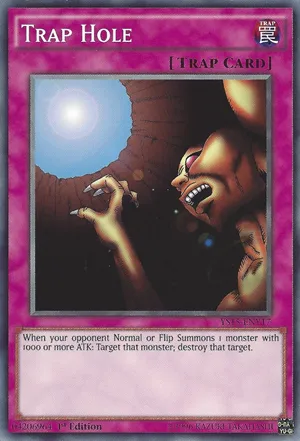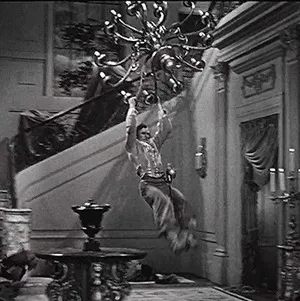My Hole Theory of Interesting Combat
Sometimes, combat in TTRPGs can get a little stale. OSR games often aim to prevent this by making combat short and lethal. It’s not long enough to get boring, and the lethality encourages players to engage with it in interesting ways, such as finding favorable conditions to fight under, leading enemies away, or trying to poison the enemies first. All of that preparation is fun! But sometimes you have a fight on even terms, and once the initiative is rolled, some fights reduce to both sides just rolling to hit each other until the other side falls over. Unexciting at best!
There are a lot of ways to fix this. Giving players consumables or magic items can give them more options, and enemies can surrender as their ranks start to thin, so that combat doesn’t get too drawn out. But I have found a simple solution for making combat encounters more interesting and memorable.
Just put a hole in the room

No, seriously. Just add a big hole to any room where combat is likely to take place. Every time I have done this, the fight becomes about the hole. Players will try to throw enemies in, or knock their weapons into the pit, or they’ll take precautions not to fall in themselves, or they’ll try to circle around it to keep enemies on the other side. You can put the funkiest monster in this room for the players to fight, and there’s a decent chance that when recounting the fight later, they will refer to it as “the fight with the hole”.
Even if the players don’t really need to use the hole to win the fight, a lot of them will want to. The hole’s call is too enticing; few players can resist. You even see this in video games. If you have a level or a map with a hole in it, suddenly everyone is trying to knock their enemies into the hole, whether it's an effective way to win or not.
The best part about the hole is that there are so many ways to vary it for reuse. The first time I use the hole I usually just put regular monsters around it and make it shallow enough that falling in it is unlikely to kill you. But later, you can use variants.
A hole with acid at the bottom, a hole you can’t see the bottom of but contains an exit to a secret room, a hole with thin planks over the middle or a rope to swing on, a hole that only appears when a huge monster creates it by rising out of the ground. You can vary the enemies, too! Throw in some spiders that can climb up the sides of the hole, or flying enemies, or huge enemies that are hard to shove, but could be walked over if you manage to get them into the hole. Just when your players think they have mastered the hole, you can always just add another layer to it!
The other cool part about holes is that they don’t move, and they persist after the encounter. Once players find a hole, they can use it as a resource. They could throw a hostage in it so they can’t escape or lure a tough enemy into the room with the hole so they can push them in instead of dealing with them. A hole room is a room the players might come back to, even after they finish clearing it out.
Lots of things can be a hole
Alright, maybe it doesn’t have to literally be a hole, but I think holes are a great example of a room feature that adds drama and without adding a bunch of extra work for the GM or rules complexity for the players.
A hole is any environmental feature you can put in a room that players will immediately think about how to use against their opponents, and crucially, that you can easily make rulings on. A hole shouldn’t require you to write a bunch of new rules, and players should easily understand the basics of how they work. When things fall in a hole they take damage. Quick rulings are fun, dragging out combat is not.
Here is a d6 table of holes you can add to a dungeon.
| Roll | Hole | How it might be used |
|---|---|---|
| 1 | An actual hole | Push someone in! |
| 2 | Chandelier | Swing from it, drop it on someone |
| 3 | Hot Stew Pot | Dunk someone’s head in it, pour it onto someone, poison it and wait |
| 4 | Pile of bricks | Throw bricks at people |
| 5 | Bramble Brush | Entangle enemies in it, keep it between oneself and the enemy |
| 6 | Pig hanging from a meat hook | Slide the pig around for mobile cover, shove it into someone to knock them down |
Describe your environmental features
The key to getting players to actually use the environment is to center the useful parts in a room’s description. If there aren’t creatures in the room, make the fun interactable thing the first thing you describe. If there are creatures, make it the second.
You can even hint at how the environment might be used in your description. Describing a chandelier as “hanging precariously from a rusty hook” makes it sound very easy to knock down on top of someone. Describing it as “rocking back and forth, suspended by a sturdy iron hook” makes it sound very secure for swinging on. You don’t have to lay it on that thick. The point is just that you can plant the seeds of some ideas with your descriptions.

Lastly, try to describe fewer things that don’t matter. If all of your room descriptions end with a list of miscellaneous items that aren’t worth interacting with, your players will stop thinking of mundane items you describe as things worth interacting with. This isn’t to say every object in a room has to be intended for use in combat, but you should go into more detail only on items that either contribute to the story of the location or might be interacted with by the player. You don’t need to describe every pot and pan in a kitchen.
Make the environment worth using
If the environment isn't worth using over a regular attack, players will stop using it. They don’t have to be strictly better than normal attacks, but they need to not be strictly worse. If a player dumps a hot stew pot on an opponent, and it does less damage than if they had just swung their sword, then next time they might not interact with your stew pot!
So environmental features should do something. That thing doesn’t have to just be damage. Knocking someone in a hole could do less damage than stabbing them, but maybe the hole is deep enough that the enemy can’t reach you anymore. That’s a reason to use the hole.
Interactables can also add risky options! Swinging from the chandelier could add a bonus to your attack but force you to make an agility check to remain on your feet at the end of the attack. Using the chandelier isn’t always worth it, so players have to decide when they are comfortable risking landing prone to squeeze out some extra damage.
Lastly, interactable objects could just do more damage but be consumable or conditional! Dropping a chandelier on someone could do more damage than swinging your sword would, but you only get to do it once and you have to lure an enemy beneath it.
The goal is for the environment to add tactical options. If they become the obvious best option or are worse than all your other options, they don’t do that. Making them worse is the more dangerous option though because you train your players not to use environmental elements you put in the game in the future. If you make an environmental interaction too good, it can only mess up one room at most. Players love using the environment. It’s cinematic, and you feel clever when you do it.
So if you’re trying to spice up a combat encounter, before building a complex enemy or adding new mechanics, consider just putting a hole in the middle of the room.